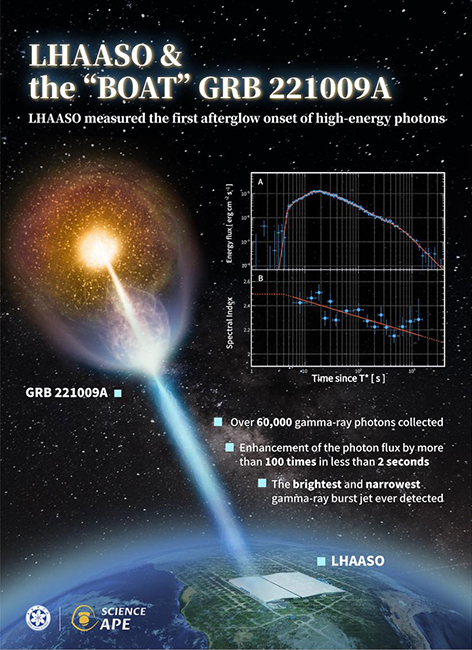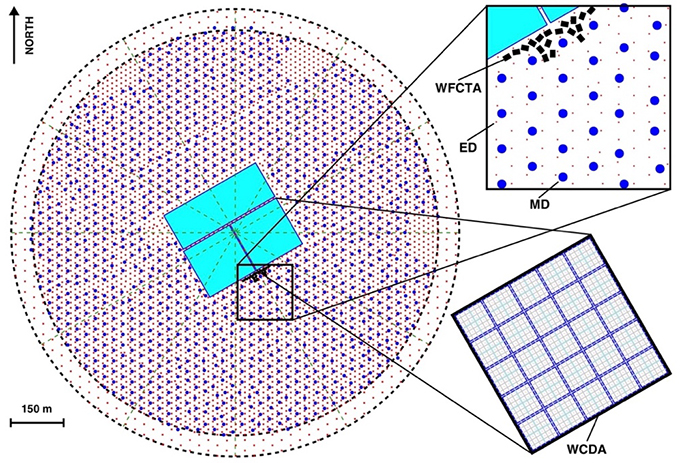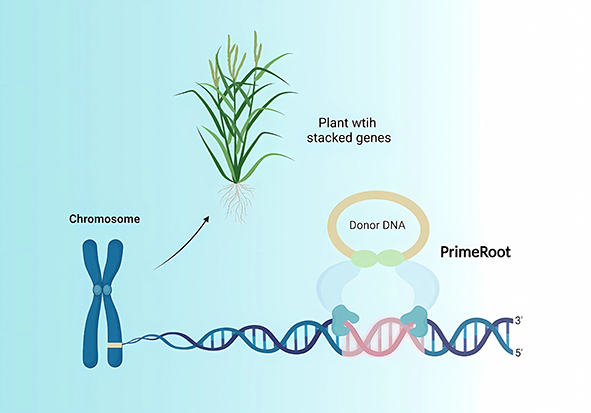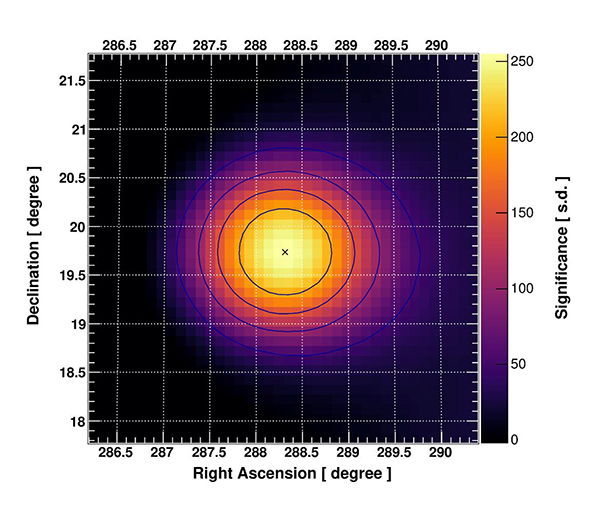7th
LHAASO Captures the Brightest-ever-observed Ultra-narrow Jet-flow and TeV Photons from a Gamma-ray Burst
With its advantageous altitude, wide field of view and excellent sensitivity, the Large High Altitude Air Shower Observatory (LHAASO), a ground-based instrument for very-high energy (VHE, over 1011 eV) cosmic ray observation, successfully detected a gamma-ray burst (GRB) broke out on October 9, 2022 (hence labeled as 221009A), and recorded the light curve as well as spectra of the subsequent tera-electronvolt (TeV, or 1012 eV) photons covering the early onset phase of the afterglow, which had never been captured before. The recorded energy of the photons extended up to 13 TeV, challenging existing theories. After analysis, the LHAASO Collaboration, an international consortium led by the CAS Institute of High Energy Physics (IHEP), reported online their discoveries on June 8, 2023 in Science and later November 15 in Science Advances.

For the first time, LHAASO captured the early onset of the afterglow of a gamma-ray burst, providing a rare opportunity to test existing theories of GRB physics. The recorded spectra extended to 13 TeV, suggesting possible new physics in play. This research ranks 7 in the top 10 annual science advances of 2023 in China.
The high-energy burst of gamma rays (photons) fell in LHAASO’s field of view “serendipitously” – as described by the authors – and offered a once-in-a-thousand-year opportunity for the researchers to understand the early onset of the explosion, for which no observational data were available. Within the first 3,000 seconds of the burst, the instrument recorded more than 64,000 photons with energies over 0.2 TeV. The team found that the VHE photons emerged several seconds after the main explosion of the GRB and soon surged in flux to peak within about 18 seconds, and suddenly speeded up the decaying process at 650 seconds later.
LHAASO detected GRB 221009A at a significance level of more than 250 standard deviations. (Image by IHEP)
The VHE energy photons, explained the team, could have come as the afterglow of the GRB 221009A, rather than the main explosion, which gave off relatively lower-energy gamma rays. The GRB itself was triggered by the collapse of a star located about 2.4 billion lightyears away from the Earth. With a mass about 20 times bigger than our Sun, the aged star, after a long time of nuclear fusion reaction, had run out of fuels. The unsustainable fusion created a negative pressure at the heart of the dying star and incurred an intensive explosion – a supernova. The outburst matter flew at a speed approaching that of light and bumped into the adjacent interstellar medium, forming very high-speed shocks, the so-called relativistic shocks. Particles were accelerated to very high energies at shocks and radiated VHE photons to produce an extremely bright afterglow lasting for hundreds of seconds. This model, called synchrotron self-Compton (SSC) process of relativistic electrons, has been proposed to explain the origin of the gamma-ray emission in GRBs. It is among the set of “nearly perfect” theories established to explain the afterglow, based on the past observations of almost ten thousand GRBs.
The accurate data from LHAASO offer an opportunity to test these theories.
“LHAASO took the lead to capture the complete onset phase of the afterglow, and precisely measure its whole evolution from the steep surge in flux, the peak and to the subsequent decay of TeV gamma rays,” introduced Prof. CAO Zhen, spokesperson of the LHAASO Collaboration. Newly elected a CAS Academician, CAO has long dedicated himself to the research in cosmic rays as a researcher at IHEP, host of LHAASO.
Energy flux light curve and spectral index evolution of the afterglow radiation from GRB 221009A, in the energy range of 0.3–5 TeV as observed by WCDA, a detector array of LHAASO, along with the fitting function. LHAASO captured the first complete afterglow observed of a GRB above 100 GeV, revealing the sharp rise in photon flux and the rapid decay in its evolution. (Image by IHEP)
Analysis on the light curve of the recorded photons found that the luminance evolved stably with energy. In their analysis and modeling, the team found that part of the observed flux variation, including the relatively slow rise at the early onset, the decaying, and even the evolution with energy can be explained well using traditional GRB models. Particularly the fast decaying is nicely fitted in the scenario of a relativistic jet blasting to the Earth, possessing a very narrow beaming structure at a half-opening angle of about 0.8°– the narrowest so far detected. In other words, the outflow of photons traveled almost exactly along the line of sight of the observer, and hence displayed the very central core of the jet flow – that explains its splendid visual brightness, the brightest so far recorded. This also is, as authors inferred, the reason why the flux seemingly “decayed” steeply at around 560 seconds after the onset – once the extremely narrow jet swung off the sight of view, even at a very small angle, the glowing core would be deviated a lot from the field of view, leaving the peripheral part of the jet-flow facing the observer, and showing a seemingly much darker ejection.
However, the team reported in the Science paper that, though the existing theories stayed valid in predicting the spectra in the decay stage, they failed to explain the sharp flux surge in the onset phase.
“For the first time, the instrument precisely observed the sharp increase in flux of the TeV photons,” said YAO Zhiguo, a researcher with IHEP and one of the corresponding authors. The early surge in flux – a steep increase of over 100 times in less than two seconds, went beyond the prediction by previous models.
Nor can the existing theories explain the photons of the highest energies. The instrument recorded spectra with energies extending up to 13 TeV, at a high level of statistical significance (over 250 standard deviations). This marked the first detection of photons beyond 10 TeV from a GRB afterglow. The unexpectedly high energies went beyond theoretical predictions and entail further exploration into issues like GRB’s energy injection, photon absorption, and particle acceleration mechanism.
To understand the involved GRB physics, the team delved into the spectral properties of the photons of the highest energies, combining data from two arrays of LHAASO, the Water Cherenkov Detector Array (WCDA) and the Kilometer Square Array (KM2A). Taking different theories into consideration, the team analyzed the data and reported on November 15, 2023 their findings in the journal Science Advances.
The authors found that the existing theories cannot fully explain the gamma-ray events of the highest energies. According to the existing models, due to the interactions of the photons with the extragalactic background light (EBL), the gamma-ray emissions should lose some energy, and at the higher end of the spectrum, the loss or absorption would go stronger due to a phenomenon called “Klein-Nishina effect”. As a result, the spectrum should “soften” or bend downwards at energies over 10 TeV. However, the observed spectra, corrected for EBL absorption at rates given by different models, would still resist softening at energies up to at least 10 TeV. This, the authors inferred, might imply that the interstellar medium could be more transparent than thought, and the actual EBL absorption could be weaker than predicted.
In other words, there could be something else in the interstellar medium interacting with the EBL to reduce the unless known absorption. In that case, suggested the authors, something more “exotic” – and more exciting – might have played some role. Possible scenarios of such new physics might include particle physics beyond standard model like Lorentz invariance violation, and potential existence of axion or axion-like particles. The team discussed such scenarios in their Science Advances paper, and further gave constraints for actual EBL intensities at different wavelengths.

LHAASO detected the first photons beyond 10 TeV from a GRB, and found that existing EBL models failed to explain the spectra of the highest energies: After corrected for EBL absorption rates as given by different models, the spectra still resist softening at least at 10 TeV. The red points are for the interval from T0 + 230 s to T0 + 300 s, while the blue points are for the interval from T0 + 300 s to T0 + 900 s. The solid lines indicate the fitted lines using the existing SSC emission model, while the red and blue points are observed spectra corrected for EBL absorption rates given by different models. (A) The intrinsic spectrum of GRB 221009A corrected for EBL absorption using the Saldana-Lopez et al. model. (B) The intrinsic spectrum of GRB 221009A corrected for EBL absorption using the Gilmore et al. model. (C) The intrinsic spectrum of GRB 221009A corrected for EBL absorption using the Dominguez et al. model. (D) The intrinsic spectrum of GRB 221009A corrected for EBL absorption using the Finke et al. model. (Image by IHEP)
“For now, lots remain unknown concerning this GRB event, and more discoveries might emerge,” said CAO, the principal investigator, “LHAASO scientists are still working on the data for further analyses, in the hope of solving more mysteries.”

An aerial view of the Large High Altitude Air Shower Observatory (LHAASO). Situated on the Mount Haizi of Daocheng County, Sichuan Province in China, its altitude at 4,410 meters above sea level puts it in a prime situation to intercept the high-energy particles in extensive air showers triggered by incoming cosmic rays, before they disappear in the atmosphere. (Image by IHEP)

Layout of LHAASO array of detectors, including the 78,000 m2 Water Cherenkov Detector Array (WCDA), one of the four arrays of detectors comprising LHAASO, as the central rectangle in blue and the enlarged detailed illustration with the mark “WCDA”. It is the hero of the observation on the GRB 221009A afterglow. Covering an energy range spanning two orders of magnitude (from around 100 GeV to few TeV) for gamma-ray observations, this detector can pick up the superhigh-speed particles bumped out by the incoming gamma-rays hitting on the upper atmosphere of the Earth, to indirectly measure the properties of the incoming photons.
References
LHAASO Collaboration; Cao, Z., Aharonian, F., An, Q., Axikegu, Bai, L. X., Bai, Y. X., . . . Zuo, X. (2023). A tera-electron volt afterglow from a narrow jet in an extremely bright gamma-ray burst. Science, 380(6652), 1390-1396. doi:10.1126/science.adg9328
LHAASO Collaboration. (2023). Very high-energy gamma-ray emission beyond 10 TeV from GRB 221009A. Science Advances, 9(46), eadj2778. doi:10.1126/sciadv.adj2778
9th
Artificial Brightness Dims Our Glucose Metabolism
From the dawn of our existence, light has been an inextricable part of life on Earth. But as modern societies increasingly embrace artificial illumination, a surprising revelation emerges: the very light that brightens our world may be dimming our metabolic health.
A new study, published in the journal Cell on January 19, 2023, unveils a previously unknown neural pathway linking light exposure to impaired glucose tolerance, shedding light on a potential culprit behind the rising prevalence of metabolic disorders, such as obesity and diabetes.
The study was conducted by a research team led by Dr. XUE Tian at the University of Science and Technology of China (USTC).
At the heart of this discovery lies a specialized group of light-sensitive neurons in the retina called intrinsically photosensitive retinal ganglion cells (ipRGCs). These cells, distinct from the more familiar rods and cones responsible for image formation, act as the body’s light detectors, sending signals to various brain regions to regulate processes like circadian rhythms and pupillary reflexes. However, the researchers uncovered an unexpected role for these ipRGCs – they form a direct neural circuit that modulates glucose metabolism by altering the activity of brown adipose tissue (BAT), a specialized fat depot crucial for regulating body temperature and energy expenditure.
Through a series of intricate experiments in mice, the researchers traced the neural pathway from the ipRGCs to the hypothalamic supraoptic nucleus (SON), then to the paraventricular nucleus (PVN), the solitary tract nucleus (NTS) in the brainstem, and finally to the rostral raphe pallidus (RPa), a region known to regulate BAT activity. Remarkably, light exposure was found to suppress adaptive thermogenesis in BAT, a process that normally helps burn off excess glucose, leading to decreased glucose tolerance. In other words, artificial brightness keeps an excessive level of glucose in the bloodstream, potentially contributing to metabolic disorders like diabetes over time.
New study unveils a previously unknown neural pathway linking light exposure to impaired glucose tolerance in mouse and human. (Image by USTC)
The researchers then extended their findings to humans, conducting glucose tolerance tests under varying light conditions. Strikingly, exposure to light, particularly blue light, decreased glucose tolerance in human participants at ambient temperatures where BAT is active. However, this effect disappeared when the tests were conducted at thermoneutral temperatures, where BAT activity is suppressed, further confirming the link between light exposure, BAT thermogenesis, and glucose metabolism.
The researchers propose this may be an evolutionary adaptation – blue light/sunlight exposure signaled the availability of food, so the body conserved and store redundant energy by reducing glucose metabolism and calorie burning when light was detected. In our modern context of constant artificial blue-enriched lighting, however, this natural response may be detrimental: at night when the body needs to clean out residual glucose in vessels to stay healthy, the blue light in modern artificial lighting could on the contrary depress the glucose metabolism to accumulate extra glucose in the bloodstream. When occurring repeatedly, this can impair the body’s ability to regulate and clear that glucose from the bloodstream efficiently after glucose intake, and hence potentially contributing to metabolic disorders like diabetes over time.
Their work suggests that the ubiquitous presence of artificial light in modern societies could be a contributing factor to the rising prevalence of metabolic diseases such as obesity and diabetes. By understanding the neural pathways involved, scientists can explore strategies to mitigate the unintended consequences of excessive light exposure on our metabolic health.
Reference
Meng, J. J., Shen, J. W., Li, G., Ouyang, C. J., Hu, J. X., Li, Z. S., . . . Xue, T. (2023). Light modulates glucose metabolism by a retina-hypothalamus-brown adipose tissue axis. Cell, 186(2), 398-412.e317. doi:10.1016/j.cell.2022.12.024











